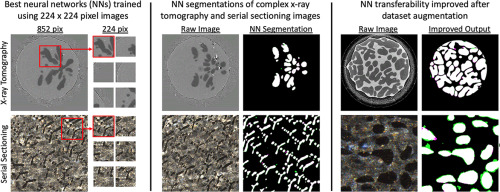当前位置:
X-MOL 学术
›
Mater. Charact.
›
论文详情
Our official English website, www.x-mol.net, welcomes your
feedback! (Note: you will need to create a separate account there.)
Optimizing convolutional neural networks to perform semantic segmentation on large materials imaging datasets: X-ray tomography and serial sectioning
Materials Characterization ( IF 4.8 ) Pub Date : 2020-02-01 , DOI: 10.1016/j.matchar.2020.110119 Tiberiu Stan , Zachary T. Thompson , Peter W. Voorhees
Materials Characterization ( IF 4.8 ) Pub Date : 2020-02-01 , DOI: 10.1016/j.matchar.2020.110119 Tiberiu Stan , Zachary T. Thompson , Peter W. Voorhees

|
Abstract Machine learning was used to segment large materials science datasets resulting from synchrotron-based x-ray computed tomography (XCT) images of dendrite growth, and serial sectioning (SS) images of dendrite coarsening. Both neural networks (NNs) yielded quantitatively more accurate outputs than conventional segmentation techniques using only 30 XCT or 6 SS training images. We show that performance can be improved if NNs are trained using a large number of small images that are sampled from the fixed amount of training data. The optimal image size and number of training images was identified for the XCT and SS datasets. NN transferability was also tested by applying the highest performing XCT and SS NNs to related datasets. While the initial segmentations were successful, applying simple transformations to the raw images further improved NN performance. These results show the great predictive ability and promising future of using machine learning for segmentation of large materials science datasets.
中文翻译:

优化卷积神经网络以对大型材料成像数据集执行语义分割:X 射线断层扫描和连续切片
摘要 机器学习用于分割由基于同步加速器的 X 射线计算机断层扫描 (XCT) 的枝晶生长图像和枝晶粗化的连续切片 (SS) 图像产生的大型材料科学数据集。与仅使用 30 个 XCT 或 6 个 SS 训练图像的传统分割技术相比,这两种神经网络 (NN) 在数量上产生了更准确的输出。我们表明,如果使用从固定数量的训练数据中采样的大量小图像来训练神经网络,则可以提高性能。为 XCT 和 SS 数据集确定了最佳图像大小和训练图像数量。通过将性能最高的 XCT 和 SS NN 应用于相关数据集,还测试了 NN 可转移性。虽然最初的细分是成功的,对原始图像应用简单的变换进一步提高了 NN 的性能。这些结果显示了使用机器学习分割大型材料科学数据集的强大预测能力和前景。
更新日期:2020-02-01
中文翻译:

优化卷积神经网络以对大型材料成像数据集执行语义分割:X 射线断层扫描和连续切片
摘要 机器学习用于分割由基于同步加速器的 X 射线计算机断层扫描 (XCT) 的枝晶生长图像和枝晶粗化的连续切片 (SS) 图像产生的大型材料科学数据集。与仅使用 30 个 XCT 或 6 个 SS 训练图像的传统分割技术相比,这两种神经网络 (NN) 在数量上产生了更准确的输出。我们表明,如果使用从固定数量的训练数据中采样的大量小图像来训练神经网络,则可以提高性能。为 XCT 和 SS 数据集确定了最佳图像大小和训练图像数量。通过将性能最高的 XCT 和 SS NN 应用于相关数据集,还测试了 NN 可转移性。虽然最初的细分是成功的,对原始图像应用简单的变换进一步提高了 NN 的性能。这些结果显示了使用机器学习分割大型材料科学数据集的强大预测能力和前景。










































 京公网安备 11010802027423号
京公网安备 11010802027423号